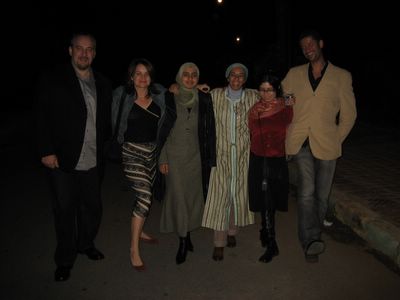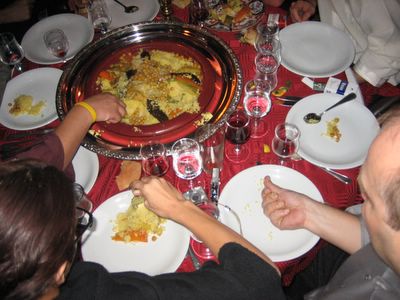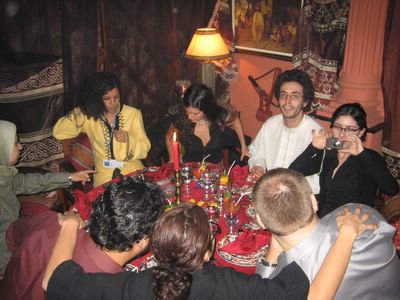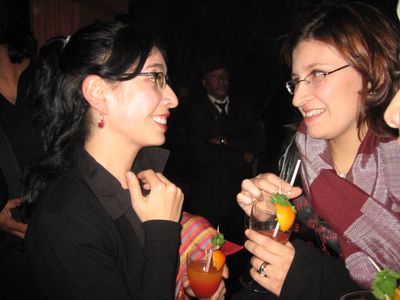SS: How did the idea for the program come about? PS: The program started when my wife Nazzy and I were in Marrakech last December for the festival. (She’s a correspondent with Voice of America, covering politics and culture, and also serves as Tribeca Film Festival Program Advisor for films from the Middle East.) At the time, we felt rather frustrated that there was only a single Moroccan film being shown in competition, while a small retrospective of Moroccan films was being shown, unsubtitled either in French or English, and only in a cinema away from the festival center. There also didn’t seem to be many Moroccan filmmakers in attendance at the screenings. Geoffrey Gilmore, an old friend who is the director of Sundance Film Festival was also one of the only other americans attending and it was clear he was being frustrated by the same things. While there, we met moroccan director Hakim Belabbes who was back for the festival though he lives in Chicago, and Khalil Benkirane, whom I knewas the director of the Arab Film Festival in San Francisco while I was still living there and running the San Francisco International Film Festival.
They asked us if we would like to meet Moroccan filmmakers and we all replied, “Of course!” We met the next afternoon in our hotel with a group of about 30 young filmmakers. We were immediately impressed by their diversity, curiosity and eagerness to learn. The women, some of whom wore headscarves, were a lot more voluble than the men and asked more questions. Some students owned cameras and some didn't. We learned at that point that there is still no formal film school in Morocco. Though they had come in conjunction with the festival, the students’ complaint was that they were not getting into the screenings, which seemed strange to us because the screenings weren't full either. The notion of doing something to make both the filmmaking process and the films being shown at the Marrakech International Film Festival more accessible to these young people just evolved naturally after that.
SS: How did the program evolve from that trip? What were the challenges in making the idea a reality?PS: We met with Faïçal Laraichi, one of the two vice chairmen of the film festival, who is also in charge of Moroccan television and an advisor to the Royal Family. A newcomer to the festival that year, he seemed sensitive to our comments and appeared willing to take steps to change what was going on. He was a huge supporter from the beginning and made things happen on the Moroccan side. He and Hakim both came to New York later in the winter and I introduced them to the team at Tribeca. They came back in April for the Tribeca Film Festival, and invited us to come to Morocco in June to pursue the idea further. So a few weeks later, we went back to Morocco, spending one amazing night at the Festival of Sacred Music in Fès, and then spending a week visiting institutions in Rabat, Casablanca and Marrakech. It turned out that though there is no actual film school, young people do succeed in studying film as part of media arts programs. We saw some student work that was encouraging. That's when we decided we were going to do a workshop. To have it during the Marrakech International Film Festival seemed like the best idea, though this didn't leave us much time to plan. It would allow the students to get see other films being screened at the festival (though it turned out that the classes were so intensive that this didn't happen as much as we would have liked), and would help draw the attention of people visiting the festival. My colleague, Madelyn Wils, director of our non-profit section, the Tribeca Film Institute, learned that the U.S. State Department had funding available for programs like this, and she was able to create a grant proposal that secured their support. Our Moroccan friends were able to muster very generous support for the equipment and space needs the program necessitated, as well as much of the travel costs involved.
SS: What do you see as the biggest victories? What were the rewards?PS: The impetus as much as the reward was that in this troubled time, young Americans who know nothing about Morocco, or any place else in the Islamic world, and young Moroccans, many of whom answered our questions about where they learned what they knew about America by saying “CNN and Al-Jazeera,” were able to make direct contact, and the feedback they all gave shows that the contact was a valuable one. It was also unexpected that for a fledgling program like this we’d be able to attract the energies and talents not only of experienced filmmaker-teachers like Hakim Belabbes (who’d been part of the project from the outset), and Katherine and Mick Hurbis-Cherrier, Associate Professors at NYU and Hunter College here in NYC, but also of two of the world’s most admired filmmakers, Martin Scorsese and Abbas Kiarostami.
Since Scorsese had shot both “The Last Temptation of Christ” and “Kundun” in Morocco, he already had important ties to the country. He was being honored with a Lifetime Achievement Award at the festival, so he would already be there. When we approached him about taking part in the workshop by offering a master class, he readily accepted. Getting Abbas Kiarostami to participate was a bigger challenge because when we first spoke to him, he had no plans to attend the Marrakech International Film Festival and, in fact, had never been to Morocco. But we knew he was curious about the country, and that he’d been giving workshops in different countries all around the world for the past several years. He agreed to our invitation to come and give a master class – and then surprised us by declaring that his master classes usually run at least ten days, while we’d only imagined he might come by for an afternoon! He was in turn surprised when the MIFF decided to honor him as well.
Concretely, the rewards were enormous. Everyone was overwhelmed by the quality and extent of the equipment the Moroccans provided. The students – who included some of the young Moroccans we’d met last year - and one camera for every pair of students, which is a remarkable; in comparison, Abbas Kiarostami had just done a similar workshop in London where there was one camera for every twelve students. When we spoke with him after the conclusion of the workshop, he expressed tremendous enthusiasm about the work and the whole workshop, and declared that the films that these students had made were the best he had seen from any of his workshops.
SS: A little known fact in America, but one that is widely known and a point of pride among Moroccans, is that Morocco's sultan was the first to officially recognize the United States of America as a nation, way back in 1777. There is a long history between the two countries, and this program shows a desire to help create the future. What is the future of this program? What happens next?PS: Bringing the Moroccan students to the Tribeca Film Festival is the other part of this. And at least four of their finished short films will be shown as part of the festival. Seifollah Samadian, Kiarostami’s cameraman and close collaborator ever since they made “ABC Africa” together in 2001, worked hard all during the workshop, shooting footage for a documentary he’s making about Kiarostami’s workshops, which we hope he’ll finish in time for us to premiere it at the next Tribeca Film Festival in April, along with the films that the students made during the workshop. By the way, at Kiarostami’s suggestion, they all made films with a single theme – in his first session, he showed the films made by students at a workshop he’d recently given in London that all used elevators as their setting. While they were discussing what theme would be appropriate for them, a student’s cell phone rang unexpectedly, and everybody immediately recognized that as a kind of “divine suggestion,” so they all made films revolving around the many ways in which cell phones are changing our lives.
Like all worthwhile film festivals, we conceive of the Tribeca Film Festival as a kind of international meeting point, so for us to send an offshoot into the world is a natural extension and addition to the program. It struck me as completely natural that we would find a home in Morocco, especially after we saw the Hassan II Mosque in Casablanca during our visit in June. Completed in 1993, the mosque stands on the Atlantic Ocean, literally suspended over it on pilings, at the westernmost point in North Africa. It is the second largest mosque in the world after the one in Mecca, and its minaret, we were told, was designed to be precisely the same height as the torch of the Statue of Liberty in New York Harbor. As we stood there it seemed evident that a cultural bridge from our country to Morocco was a natural development: the Moroccans had already manifested their yearning for it.
SS: What was your reaction when you saw the results of the program—the films the students made?I won't say anything about the films that were made. I want to give people a chance to see them at the 2006 Tribeca Film Festival. But I will say that I’m someone who is often disappointed by the kind of work people are making as a result of the so-called digital revolution, but this time I was thrilled by the results.




























